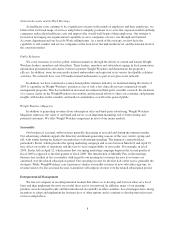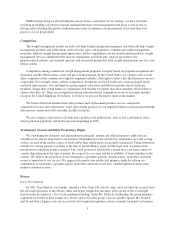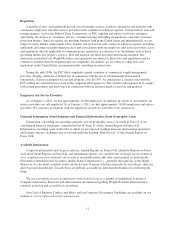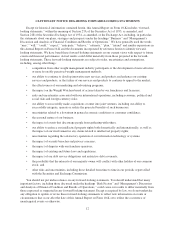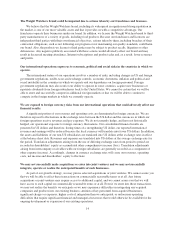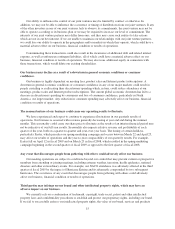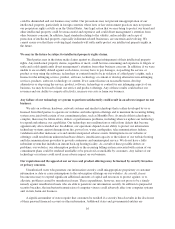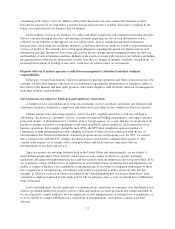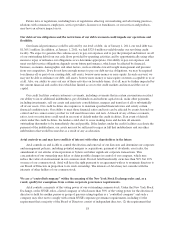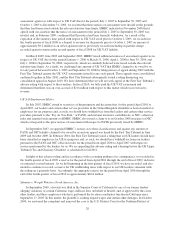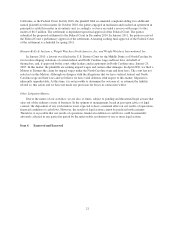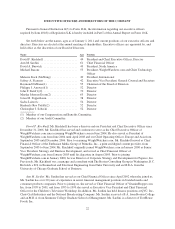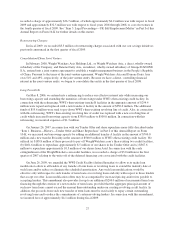WeightWatchers 2010 Annual Report Download - page 34
Download and view the complete annual report
Please find page 34 of the 2010 WeightWatchers annual report below. You can navigate through the pages in the report by either clicking on the pages listed below, or by using the keyword search tool below to find specific information within the annual report.F
uture laws or regulations, including laws or regulations affecting our marketing and advertising practices,
r
elations with consumers, employees, service providers, licensees or franchisees, or our services and products
,
may have an adverse impact on us
.
O
ur debt serv
i
ce obl
i
gat
i
ons and the restr
i
ct
i
ons o
f
our debt covenants could
i
mpede our operat
i
ons and
f
lex
i
b
i
l
i
t
y
.
Our financial performance could be affected by our level of debt. As of January 1, 2011, our total debt wa
s
$
1,365.1 million. In addition, at January 1, 2011, we had
$
325.0 million available under our revolving credit
f
acility. We expect to generate the cash necessary to pay our expenses and to pay the principal and interest on all
o
f our outstanding debt from our cash flows provided by operating activities and by opportunistically using other
means to repay or refinance our obligations as we determine appropriate. Our ability to pay our expenses an
d
meet our debt service obligations depends on our future performance, which may be affected by financial
,
business, economic, demographic and other factors, such as attitudes toward weight management and pressur
e
f
rom our competitors. If we do not have enough money to pay our debt service obligations, we may be required
to refinance all or part of our existing debt, sell assets, borrow more money or raise equity. In such an event, w
e
may not be able to refinance our debt, sell assets, borrow more money or raise equity on terms acceptable to us or
at all. Also, our ability to carry out any of these activities on favorable terms, if at all, may be further impacted by
the current financial and credit crisis which has limited access to the credit markets and increased the cost of
ca
p
ital.
Our credit facilities contain customary covenants, including covenants that in certain circumstances restrict
o
ur ability to incur additional indebtedness, pay dividends on and redeem capital stock, make other payments,
including investments, sell our assets and enter into consolidations, mergers and transfers of all or substantiall
y
all of our assets. Our credit facilities also require us to maintain specified financial ratios and satisfy certain
f
inancial condition tests. Our ability to meet those financial ratios and tests can be affected by events beyond ou
r
control and we cannot assure you that we will meet those ratios and tests. A breach of any of these covenants,
r
atios, tests or restrictions could result in an event of default under the credit facilities. If an event of defaul
t
exists under the credit facilities, the lenders could elect to cease making loans and declare all amount
s
o
utstanding thereunder to be immediately due and payable. If the lenders under the credit facilities accelerate the
p
ayment of the indebtedness, our assets may not be sufficient to repay in full that indebtedness and our other
indebtedness that would become due as a result of any acceleration
.
Artal controls us and ma
y
have con
f
l
i
cts o
fi
nterest w
i
th other shareholders
i
n the
f
uture
.
A
rtal controls us and is able to control the election and removal of our directors and determine our cor
p
orat
e
and management policies, including potential mergers or acquisitions, payment of dividends, asset sales, the
amendment of our articles of incorporation or bylaws and other significant corporate transactions. Thi
s
concentration of our ownership may delay or deter possible changes in control of our company, which ma
y
r
educe the value of an investment in our common stock. Even if Artal beneficially owns less than
5
0% but 10
%
o
r more of our common stock, Artal will have the right pursuant to an agreement with us to nominate directors to
o
ur Board of Directors in proportion to its stock ownership. The interests of Artal may not coincide with th
e
interests of other holders of our common stock
.
We are a “controlled company” within the meaning of the New York Stock Exchange rules and, as a
r
esult, qual
if
y
f
or exempt
i
ons
f
rom certa
i
n corporate governance requ
i
rements.
A
rtal controls a majority of the voting power of our outstanding common stock. Under the New York Stoc
k
Exchange, or the NYSE, rules, a listed company of which more than
5
0% of the voting power for the election of
directors is held by another person or group of persons acting together is a “controlled company” and such a
company may elect not to comply with certain NYSE corporate governance requirements, including (1) th
e
r
equirement that a majority of the Board of Directors consist of independent directors, (2) the requirement tha
t
18


